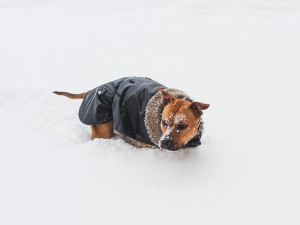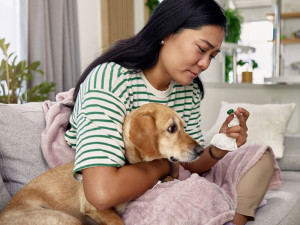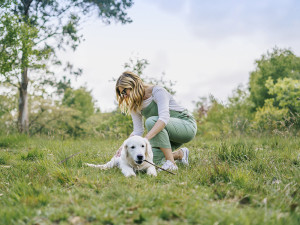What is Leptospirosis?
Everything you need to know about the potentially deadly disease

Share Article
File this under ‘Yet Another Thing for Pet Parents to Worry About’: leptospirosis is a zoonotic bacterial disease, meaning it affects both humans and animals, and can readily spread from one species to another (ie, from our dogs to us). Historically, ‘lepto’ cases were most common among farmers and soldiers in tropical climates, however outbreaks in New York City in 2017, and Los Angeles, Corfu and the Pacific Islands in 2023 have claimed the lives of people and their pets, renewing concern over this disease.
Leptospirosis, also known as Weil’s disease, is still very unlikely to be spread from pets to humans and is very rare in the UK. However, with frequent storms and adverse weather conditions in recent months causing heavy rain and flooding across the UK, the risk of spreading any waterborne disease in contaminated soil or water is increased.
If your dog contracts leptospirosis, the extent of care needed depends on the severity of disease, and how developed it is at the point of diagnosis, but treatment generally requires a course of antibiotics and supportive therapy. Here’s what you need to know.
What causes leptospirosis?
Leptospirosis in dogs is caused by the Leptospira bacteria, which is spread through the urine of infected animals into the soil and water – most commonly rodents such as rats and mice, and farm animals such as cows and pigs. As dogs come in contact with a contaminated area, the bacteria can be absorbed through their skin and mucous membranes (gums, nose, eyes) or through drinking the contaminated water.
Leptospira bacteria can survive and thrive for up to 180 days given the right conditions; namely, warm, damp environments and stagnant water. That said, Leptospira do need moist soils to survive, and they will rapidly die on dry surfaces. Spending time in areas densely populated with other animals (and their urine) increases the risk of exposure.
Symptoms of leptospirosis
The clinical signs of leptospirosis in dogs can be vague and mimic those of many other diseases: fever, lethargy, loss of appetite, muscle stiffness, vomiting and diarrhoea. Jaundice – the yellowish discolouration of the gums or whites of the eyes – is typically the first sign. In severe cases, this disease moves rapidly and can turn fatal pretty quickly. In mild cases, dogs may show no symptoms at all, and the disease may even go undetected.
How is leptospirosis diagnosed?
Unfortunately, since leptospirosis in dogs often looks like other diseases, confirming an infection is generally not easily done when your pet walks into the vets; but rather, tends to require a couple of rounds of testing if the initial blood tests and urinalysis look suspicious. What raises suspicion of a Leptospira infection are elevated kidney and liver values, and sometimes the white blood cell count, too. If this is observed, your vet will then recommend a special blood and urine test. Results can take several days, and so antibiotic treatment is often started prophylactically, pending the results.
Thankfully, most infections are subclinical, which means observable leptospirosis symptoms will not likely develop, nor will your pet will experience true illness. However, if your pet does develop sudden signs of the disease, and those signs appear severe, the prognosis is generally guarded (there’s a 50/50 chance of survival). Without immediate treatment, leptospirosis can lead to kidney failure, liver failure and even death. Blood or plasma transfusions are sometimes needed if your dog’s body loses its ability to clot due to liver compromise. Yes: this is one bad bug.
How can you keep you and your dog safe?
In general, it’s important to minimise your dog’s access to areas populated by rodents and farm animals to limit the risk of exposure. When walking with your dog in rural areas, when possible, watch out for areas heavily trafficked by wildlife. Keep your garden free of stagnant water and clean your home often – especially in areas where there is pet urine.
In cities, rats are harder to avoid, so steer clear of puddles and don’t let your pet drink from communal water bowls at parks or those put out by local businesses, as you don’t know how often the water is refreshed or bowl cleaned (thanks but no thanks). If your dog attends daycare, get your pet vaccinated – more on that below.
“Cases of leptospirosis tend to spike in the late summer and autumn, or, in cooler climates, during rainy winters,” says Ashley DiPreteopens in new tab. “Outbreaks tend to follow seasons with abnormally high rainfall or increased flooding.” So, since we’ve been experiencing high rainfall and flooding recently in the UK, now’s the time to be vigilant.
Do leptospirosis vaccines work?
Yes and no. Vaccines for leptospirosis contain what are known as ‘serovars’ or strains, which are components of the bacteria used to stimulate protection from disease. But, there’s a catch. There are at least nine strains that can cause the disease, yet the vaccine contains only a fraction of these, offering incomplete protection. So, pet parents often have a false sense of security that their dog is protected because they have been vaccinated, but this is not always the case.
Not to mention, immunity only lasts 6–8 months, so some veterinarians recommend vaccinating high-risk dogs (such as dogs who hunt, show dogs, dogs with frequent access to lakes and those living in endemic areas) every 4–6 months. Vaccines do not come without risk, either, so talk to your veterinarian about your dog’s risk of exposure and the most common local strains found in your area. They will be able to recommend a vaccine protocol (or not) that makes sense for your dog.

Dr. Shea Cox, DVM, CVPP, CHPV
Dr. Shea Cox is the founder of BluePearl Pet Hospice and is a global leader in animal hospice and palliative care. With a focus on technology, innovation and education, her efforts are changing the end-of-life landscape in veterinary medicine.
Related articles
![Veterinarian examining a dog]()
HGE in Dogs: Causes, Symptoms and Treatment
Certain symptoms could mean your dog is battling a potentially fatal condition called haemorrhagic gastroenteritis (HGE). Here’s everything you need to know
![Woman holding a beagle in warm dappled summer light]()
You’ve Got a Summer-Lovin’ Pup. Here’s How to Keep Them Safe
Some like it hot (but not most dogs). Here are the season’s health hazards, from fleas to grass seeds
![Woman taking temperature of her brown dog.]()
What Should Your Dog’s Temperature Be? A Step-by-Step Guide on Taking Your Dog’s Temperature at Home
Spoiler: there are more ways than the one you’d rather avoid
![Two english pointers sniffing in the dirt outside.]()
Ringworm in Dogs: Recognising Symptoms and Treatment of Canine Ringworm
Ringworm isn’t fun for anyone, but it is treatable – and preventable
![A woman checking her dog for ticks outside in a grassy field.]()
Lyme Disease in Dogs: What Every Dog Parent Should Know
We asked a vet for tips on how to prevent the tick-borne Lyme disease in dogs
![Brown Dachshund dog wearing a gray and white striped handkerchief and laying on blankets]()
Staying On Top of Canine Melanoma
Dog melanoma can develop in many places on a dog’s body. Here’s everything you need to know about what causes melanoma and its symptoms









